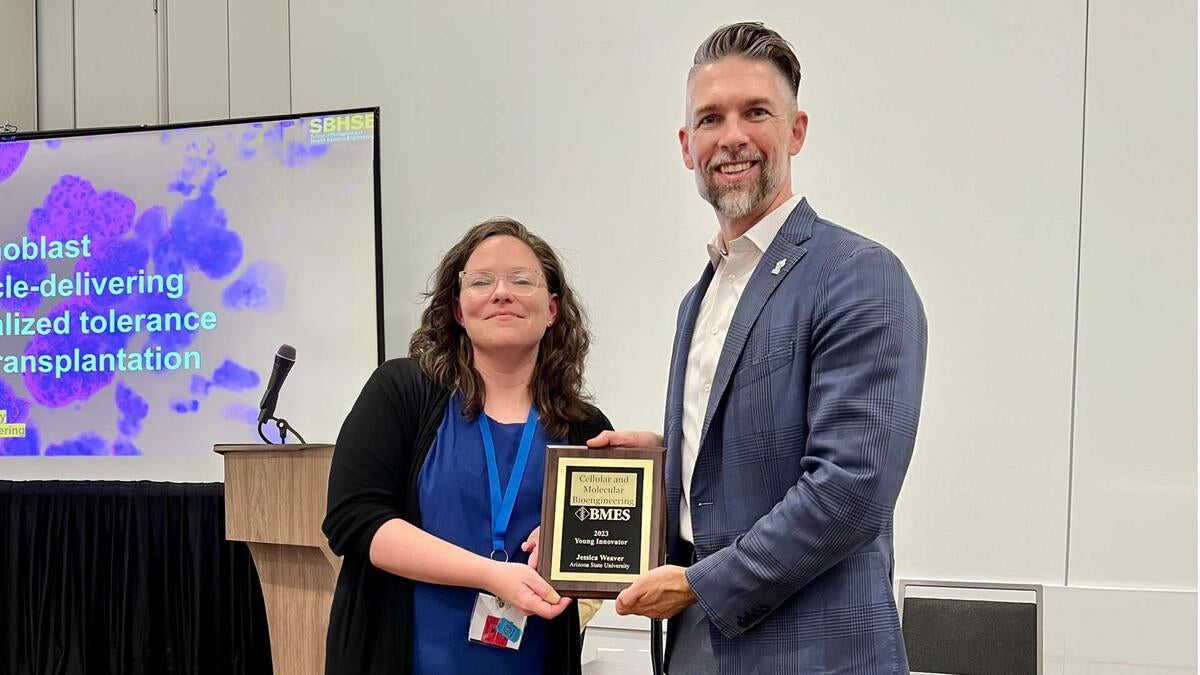Innovative immune system approach earns ASU researcher honors

Jessica Weaver (left), an assistant professor of biomedical engineering in the Ira A. Fulton Schools of Engineering at Arizona State University, accepts the 2023 Young Innovators of Cellular and Molecular Bioengineering award for her publication in the journal Cellular and Molecular Bioengineering at the Biomedical Engineering Society’s annual meeting. Weaver was honored for her work in tissue engineering, immunology and biomaterials. Photo courtesy Jessica Weaver
Jessica Weaver, an assistant professor of biomedical engineering in the School of Biological and Health Systems Engineering, part of the Ira A. Fulton Schools of Engineering at Arizona State University, has been selected as one of the 12 Young Innovators of Cellular and Molecular Bioengineering for 2023.
The award, bestowed by the journal Cellular and Molecular Bioengineering, or CMBE, recognizes her novel hydrogel and approach to manipulating immunological responses.
Every year, CMBE highlights the most innovative and impactful bioengineering studies carried out by junior faculty in the field of biomedical engineering. Winners were invited to present their work at the Biomedical Engineering Society’s annual meeting. Weaver was honored in the Innovative Materials and Therapeutic Strategies category for her work in tissue engineering, immunology and biomaterials.
“I watch these awards every year so it’s something I’ve aspired to for a while,” Weaver says. “There are a lot of biomedical engineers out there, so to be considered as one of the young innovators is an honor.”
Heather Clark, director of the School of Biological and Health Systems Engineering, says it is impressive though not unexpected that Weaver has been honored with an award recognizing her innovation and impact in the field of bioengineering.
“Jessica’s research consistently introduces fresh ideas to address long-standing health care challenges,” Clark says, “all while maintaining a strong focus on the goal of improving outcomes for patients.”
Responding to the reaction
Of the many marvels within the human immune system, the most defining feature is its capacity to recognize what is or is not part of an individual’s body. When these functions proceed correctly, they allow the body to fight off pathogens; when it goes awry, it results in autoimmune disorders.
Though this is a valuable benefit of the immune system, it can cause problems during certain treatments, such as cell or organ transplantation, in which the body rejects the foreign tissue that is meant to restore a missing function.
Current treatments to decrease the risk of rejection involve immunosuppressant medication. However, immune system suppression is risky, as it can leave the patient vulnerable to other illnesses.
Weaver says this risky immunological suppression stands in the way of potential cures for diseases such as Type 1 diabetes.
“Every patient receiving an organ or cell transplant has to go on immune suppressant drugs, and the risks of those drugs are high," she says. "For many patients, the acute risks of those drugs are not worth it.”
Tolerating treatment
Weaver and the researchers in her lab investigated how cells communicate during pregnancy — the only naturally occurring phenomenon where the body doesn’t reject foreign cells. The team says that trophoblasts, which are the cells that form the placenta, communicate through particles known as extracellular vesicles, some of which contain molecules called tolerogenic factors that regulate the immune system’s response.
Weaver and her team engineered a way to use hydrogel biomaterials to deliver the extracellular vesicles to a cell transplantation site. Using this method, they hope to locally eliminate the body’s immune response to locally transplanted cells, which would avoid weakening the entire body.
“We created a different system for delivering these extracellular vesicles that have them tethered to the hydrogel so it will slowly diffuse to last longer,” Weaver says. “Nobody has ever used trophoblasts as a therapy like this before.”
Weaver’s approach using trophoblasts is called “placental mimicry” and is also being developed through her startup, Immunoshield Therapeutics, where the team is working on establishing efficacy and dosage. She is optimistic about the hydrogel’s potential to spare patients from the challenges of immunosuppressants while improving their prognosis. Furthermore, increased acceptance of hydrogel biomaterials may also increase the longevity of donor organs and enable treatment for more patients in need.
“I’ve always been interested in how technology translates into industry and patient care,” Weaver says. “It’s exciting to be moving closer to clinical testing so we can ultimately get patients access to our technology.”
More Science and technology

ASU postdoctoral researcher leads initiative to support graduate student mental health
Olivia Davis had firsthand experience with anxiety and OCD before she entered grad school. Then, during the pandemic and as a…

ASU graduate student researching interplay between family dynamics, ADHD
The symptoms of attention deficit hyperactivity disorder (ADHD) — which include daydreaming, making careless mistakes or taking…

Will this antibiotic work? ASU scientists develop rapid bacterial tests
Bacteria multiply at an astonishing rate, sometimes doubling in number in under four minutes. Imagine a doctor faced with a…